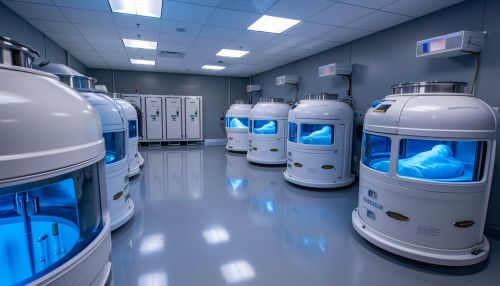Cryonics
Overview
Cryonics is the low-temperature preservation of humans and animals who can no longer be sustained by contemporary medicine, with the hope that resuscitation and restoration to full health may be possible in the future. Cryonics is regarded with skepticism within the mainstream scientific community and is not part of normal medical practice. It is not known if it will ever be possible to revive a cryopreserved human being.


History
The concept of cryonics was first proposed in 1962 by Robert Ettinger in his book The Prospect of Immortality. The first person to be cryopreserved was Dr. James Bedford in 1967. Since then, about 250 bodies have been cryopreserved in the United States, and 1,500 people have made arrangements for cryopreservation after their legal death.
Procedure
Cryonics procedures can begin only after clinical death, and use cryoprotectants to prevent ice formation during cryopreservation. The process is not reversible with present technology; cryonicists hope that medical advances will someday allow cryopreserved bodies to be revived.
Cryoprotectants
Cryoprotectants are used to reduce ice damage. The first cryoprotectant solutions able to vitrify at very slow cooling rates while still being compatible with whole organ survival were developed in the late 1990s by cryobiologists Gregory Fahy and Brian Wowk for the purpose of banking transplantable organs.
Vitrification
In the context of cryonics, "vitrification" refers to the conversion of the body, or parts of it, into a glass-like, amorphous solid. This is not freezing, since no ice crystals are formed.
Storage
Cryopreserved bodies are stored in a cryonics facility, also known as a "patient care bay". The bodies are stored at a temperature below -130°C, typically in liquid nitrogen.
Legal aspects
In the United States, cryonics can only be legally performed on humans after they have been pronounced legally dead. This leads to a critical loss of time, since the lack of circulation causes brain cells to begin dying within 4–6 minutes.
Ethics
The ethical debate surrounding cryonics is complex and multifaceted. It touches on issues of personal identity, the definition of death, the sanctity of the human body, and the limits of parental rights.
Cryonics in popular culture
Cryonics has been the subject of many works of science fiction, and its cultural perception is often shaped by these depictions. Some of the most well-known include the movies Forever Young and Austin Powers: The Spy Who Shagged Me.
